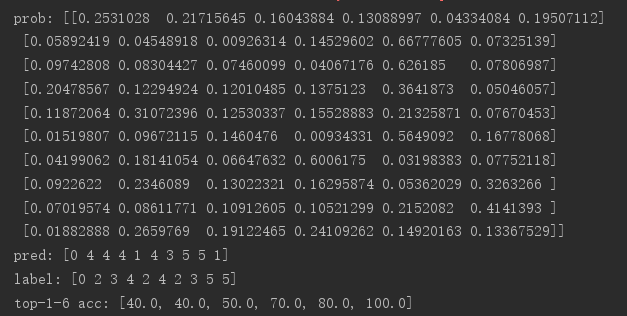本篇记录一下TensorFlow中张量的排序方法
tf.sort和tf.argsort
# 声明tensor a是由1到5打乱顺序组成的 a = tf.random.shuffle(tf.range(5)) # 打印排序后的tensor print(tf.sort(a,direction='DESCENDING').numpy()) # 打印从大到小排序后,数字对应原来的索引 print(tf.argsort(a,direction='DESCENDING').numpy()) index = tf.argsort(a,direction='DESCENDING') # 按照索引序列取值 print(tf.gather(a,index)) # 返回最大的两个值信息 res = tf.math.top_k(a,2) # indices返回索引 print(res.indices) # values返回值 print(res.values)

计算准确率实例:
# 定义模型输出预测概率 prob = tf.constant([[0.1,0.2,0.7],[0.2,0.7,0.1]]) # 定义y标签 target = tf.constant([2,0]) # 求top3的索引 k_b = tf.math.top_k(prob,3).indices # 将矩阵进行转置,即把top-1,top-2,top-3分组 print(tf.transpose(k_b,[1,0])) # 将y标签扩展成与top矩阵相同维度的tensor,方便比较 target = tf.broadcast_to(target,[3,2]) # 实现求准确率的方法 def accuracy(output,target,topk=(1,)): maxk = max(topk) batch_size = target.shape[0] pred = tf.math.top_k(output,maxk).indices pred = tf.transpose(pred,perm=[1,0]) target_ = tf.broadcast_to(target,pred.shape) correct = tf.equal(pred,target_) res = [] for k in topk: correct_k = tf.cast(tf.reshape(correct[:k],[-1]),dtype=tf.float32) correct_k = tf.reduce_sum(correct_k) acc = float(correct_k/batch_size) res.append(acc) return res
import tensorflow as tf import os os.environ['TF_CPP_MIN_LOG_LEVEL'] = '2' tf.random.set_seed(2467) def accuracy(output, target, topk=(1,)): maxk = max(topk) batch_size = target.shape[0] pred = tf.math.top_k(output, maxk).indices pred = tf.transpose(pred, perm=[1, 0]) target_ = tf.broadcast_to(target, pred.shape) # [10, b] correct = tf.equal(pred, target_) res = [] for k in topk: correct_k = tf.cast(tf.reshape(correct[:k], [-1]), dtype=tf.float32) correct_k = tf.reduce_sum(correct_k) acc = float(correct_k* (100.0 / batch_size) ) res.append(acc) return res output = tf.random.normal([10, 6]) output = tf.math.softmax(output, axis=1) target = tf.random.uniform([10], maxval=6, dtype=tf.int32) print('prob:', output.numpy()) pred = tf.argmax(output, axis=1) print('pred:', pred.numpy()) print('label:', target.numpy()) acc = accuracy(output, target, topk=(1,2,3,4,5,6)) print('top-1-6 acc:', acc)
